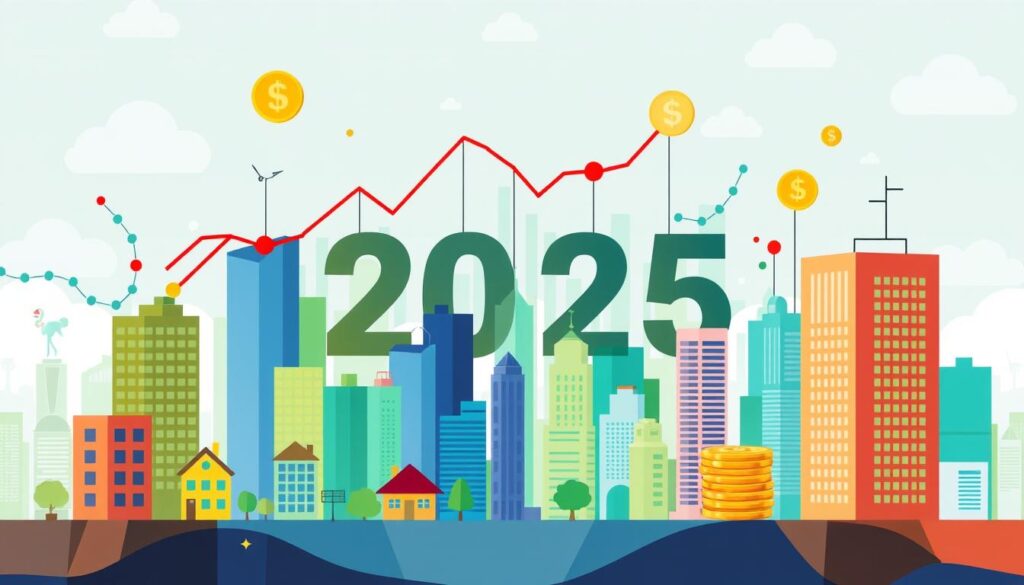Are you ready to find the best real estate investments for 2025? The real estate world is always changing. Smart investors need to keep up with new trends and markets.
Smaller cities are growing because of remote work. There’s a big demand for green and tech properties. These changes make real estate exciting and full of chances.
In this detailed article, we’ll look at what’s shaping the real estate market in 2025. We’ll also find the top investment spots that could grow your portfolio. This guide is for both new and experienced investors. It will help you make smart choices and grab the best real estate chances for the future.
Table of Contents
Market Overview: Real Estate Landscape in 2025
The real estate market in 2025 is expected to slowly recover. High interest rates and peak construction activity have been big challenges. Economic indicators and global investment trends will play key roles in shaping the market.
Current Market Dynamics
Cap rates are likely to drop as interest rates fall. This could lead to more property value and rental income. The Federal Reserve’s policy changes will also affect cap rates, especially in areas like the Sun Belt.
New apartment construction is expected to decrease by 20% in 2024 and 2025. This will likely cause rental rates to rise in many U.S. markets. The shortage of housing is a major factor in this trend.
Economic Indicators Impact
Delinquency rates for commercial real estate collateralized loan obligations (CLOs) have risen from less than 1% to 7% since the pandemic, indicating the need for cautious investment strategies. Liquidation values have dropped by 20%-40%. Recent deals in the core-focused sector are trading at 20%-25% less than 2021 levels.
Global Investment Trends
- The residential sector, particularly in areas like the Sun Belt, is favored by investors due to the region’s strong population and job growth.
- Data centers are emerging as a top investment choice in Europe, driven by growing global demand and regulatory requirements.
- The life sciences sector faces challenges with decelerating net absorption due to new supply and reduced tenant demand.
- Investors are advised to consider allocating across public and private equity and debt for tactical trade opportunities, as there is a gap between public and private markets that may need to be reconciled in the future.
As the real estate market moves past the pandemic, it’s vital to understand the current dynamics, economic indicators, and global trends. This knowledge will help investors and professionals find and seize opportunities in 2025.

The Rise of Secondary City Markets
Investors are now looking at secondary city markets, like Boise, Charlotte, and Tampa. These cities are growing fast and becoming great places to invest. They offer a chance to make money in new and exciting ways.
Remote work has changed how people live. Now, people can work from anywhere, not just big cities. This means more people are moving to places like Boise and Tampa for better living conditions and lower costs.
These moves have sparked big changes in these cities. They are getting new life through urban renewal projects. This has opened up new chances for investors to make money in these secondary city markets.
Investors find these cities appealing because they are cheaper and growing faster. They offer a chance to make more money than in crowded big cities. By spotting and investing in these areas, smart investors can find new ways to earn.

The growth of secondary city markets is a big chance for investors. It lets them spread out their investments and take advantage of new trends. By keeping up with these changes, investors can do well in the future.
Sustainable and Green Building Investments
Nowadays, the real estate world focuses a lot on being green. Developers use eco-friendly materials and green building methods. This is because buyers want properties with features like solar panels and geothermal heating. Properties with green certifications or LEED compliance are in high demand. They also get higher returns and attract tenants who care about the environment.
LEED Certification Benefits
LEED certification does more than help the planet. It shows a building is energy-efficient, saves water, and has good air inside. This can mean lower costs and a higher property value. Investing in sustainable real estate can be very rewarding.
Energy Efficiency Returns
Building with energy-saving features and renewable energy can be very profitable. Properties with high-performance insulation, LED lighting, and smart home technology can charge more rent. They also use less energy, which saves money.
Environmental Impact Considerations
The real estate world is now more aware of its environmental impact. Investors are looking at how their choices affect the planet. Sustainable housing and eco-friendly projects are becoming more popular. This is because people want properties that are good for the environment.
By choosing sustainable practices and green investments, real estate experts can lead the market. They meet the needs of eco-conscious buyers. This helps create a greener built environment.
Build-to-Rent Communities Evolution
The real estate world is changing fast, with build-to-rent (BTR) communities leading the way. Home prices are high, and more people are choosing to rent long-term. BTR communities offer homes with shared amenities like gyms and parks.
This shift opens up new chances for investors looking for steady income. Investment firms are pouring money into BTR projects. For example, Pretium raised over $1.5 billion for a $3 billion-plus investment. This shows a big commitment to this new type of property.
Investors in BTR can quickly make decisions and act fast. This agility helps them keep up with the fast-changing rental market. They can quickly find and buy good properties.
As more people want to rent long-term, investors in BTR might see big profits soon. But experts also say it’s key to offer rent-to-own options. This can help make renting a stepping stone to owning a home.
The rise of BTR communities marks a big change in real estate. It meets the needs of today’s renters. By jumping on this trend, investors can grow their portfolios and earn steady rental income.
Top Real Estate Investment Opportunities in 2025
The real estate world is changing fast, and smart investors are looking for the best places to put their money in 2025. They’re focusing on high-growth markets and new emerging asset classes. The real estate field is full of investment strategies that could bring big profits for those who research well.
High-Growth Markets
The Sun Belt region is a top pick for 2025. Cities like Phoenix, Atlanta, and Dallas are booming. They have lots of jobs, growing populations, and strong economies, making them great for real estate investors.
Emerging Asset Classes
Investors are also looking at new areas like data centers and student housing. Data centers in Europe are in high demand because of digital needs and data rules. Student housing is growing as more students enroll worldwide.
Investment Strategies
- Investing in sustainable and green buildings can be profitable and good for the planet. These buildings meet LEED standards.
- Build-to-rent communities offer steady rental income and the chance for property value to go up.
- Multifamily housing in Asia and big cities is a good choice. Rental demand is high because of changing demographics and more people working from home.
By keeping up with real estate trends and opportunities, investors can do well in 2025 and later. With the right approach and knowledge of new trends, making passive income through real estate is still a good idea.
Technology Integration in Real Estate
The real estate world is changing fast, thanks to proptech, AI in real estate, and blockchain for property transactions. These new tools help investors work smarter, save money, and stay ahead.
Artificial intelligence (AI) and automation are big trends now. AI tools help find and check tenants, manage repairs, and spot problems early. This makes tenants happier and helps investors manage their properties better.
Blockchain is also changing how we buy and sell properties. It makes transactions faster, safer, and more reliable. This means less paperwork and quicker deals.
Data analytics play a big role too. Investors use big data and predictions to make better choices. This helps spot new chances and avoid risks.
To stay on top, investors need to use proptech, AI, and blockchain. This way, they can work more efficiently, save money, and offer a great experience for everyone.
The future of real estate is digital, and those who adapt will do well. It’s an exciting time for the industry.
Multifamily Housing Market Trends
The multifamily housing sector is set for growth in 2025. This is due to the high cost of single-family homes. High mortgage rates are making people stay in rentals longer. This is especially true in cities like Phoenix, Dallas, and Houston.
Demographic Shifts
Changes in demographics are boosting rental demand. Younger people and families are choosing rentals over buying homes. The growing population in the South is also driving up rental prices in those areas.
Rental Demand Patterns
- Rental rates are expected to rise by 3% or more in about one-third of the top 50 U.S. markets. This is due to strong demand and a tight supply.
- Cities in the Sun Belt, such as Phoenix, Atlanta, and Dallas, are expected to lead in multifamily investments in 2025.
- The multifamily market in 2025 will face challenges, especially in Sunbelt markets, due to a supply glut.
Investors in markets with tight supply and strong job growth will do well. The industry will keep evolving. Technology and sustainability will be key in shaping its future.
Commercial Property Investment Outlook
The commercial property investments scene is slowly getting better, with some good news popping up. Class A buildings, the top ones, might have hit rock bottom and are now selling for less than they cost to build. But, the future for Class B and C properties, especially in office space trends and life sciences, is still up in the air. They might still see their values drop.
The office space trends are getting more divided, with people wanting better, greener spaces. This chance for owners and lenders to improve properties is great, but it also shows the dangers for weaker spots. They might lose tenants over time. The retail real estate outlook is also careful, as retail deals with changing shopping habits and online shopping’s rise.
Despite the mixed signs, investors are diving into the commercial property market, bringing in a lot of money. Experts say this could be the best time in 15 to get into commercial property. This is because owners and lenders are looking for ways to get financing in a changing market.
The commercial property sector’s recovery might take time, but the growing interest from investors and the chance to upgrade existing properties offer hope. For those ready to understand the market’s complexities, there are opportunities ahead. As always, thorough research, careful analysis, and a sharp eye for new chances will help make the most of commercial property investments in the future.
Sun Belt Region Investment Potential
The Sun Belt region covers eighteen states in the Southeast and Southwest. It’s a top spot for real estate investors in 2025. With seven of the ten largest U.S. cities, it’s home to over 50% of the nation’s people.
Market Performance Metrics
The Sun Belt’s economy is strong. It saw a 20% increase in jobs over ten years, beating the 9% growth elsewhere. Texas, Florida, and Arizona are expected to add over 7 million people by 2033.
These states have more than half of the nation’s leisure and hospitality jobs. Cities like Austin, Denver, and San Jose have lots of Millennials.
Growth Opportunities
- Affordable real estate in cities like Dallas-Fort Worth, Miami, and Austin attracts investors.
- The tech boom in Austin is driving demand for housing. But, affordability is becoming a big issue.
- Secondary markets in the Midwest and Southeast, like Columbus and Fayetteville, offer good investment chances. They have affordable prices, growing economies, and are great for remote work.
The Sun Belt is more than just growing fast and having a strong economy. It also has good taxes, a diverse workforce, and a nice climate. These factors draw businesses and people, making it a great place for real estate investors.
Data Center Real Estate Opportunities
The data center industry is booming, especially in Europe. The demand for data centers is growing fast, but Europe is behind the U.S. in meeting this need. This is because of rules that make countries keep important data within their borders.
In Europe, the story of data centers catching up is five to seven years behind the U.S. This means there are big chances for investments and tech real estate.
Today, we need about 60 gigawatts of data center power worldwide. But by 2030, we’ll need 170 to 220 gigawatts. This is a huge jump, showing we need to triple our capacity.
The biggest cloud computing providers, known as hyperscalers, will use 65 to 70 percent of all computing power by 2030. This will also boost the need for digital infrastructure.
Real estate companies have three main ways to get into the data center business. They can buy land, help build data centers, or build them fully. Data center land lasts about 25 to 30 years. Cooling and electrical parts last 10 to 20 years.
Data centers are a good investment because they offer high yields. This is because there’s not enough supply to meet demand. The growing need for data storage and processing makes data center real estate a great chance for investors.
- The current total data center critical IT demand worldwide is approximately 60 gigawatts.
- By the end of the decade, the projected demand for data centers is estimated to be between 170 to 220 gigawatts.
- Hyperscalers are expected to utilize 65 to 70 percent of computing power by the end of the decade.
Student Housing Investment Prospects
Investors are now focusing on the student housing market. This sector offers great growth chances. It meets the growing need for places to live, often more than dorms can provide.
Student housing uses a per-bed leasing model. Leases match the school year. This makes it a stable and resilient investment, even when the economy is down.
Market Analysis
The student housing market is growing fast. More students are looking for places to live, and dorms can’t keep up. Private student housing is becoming more popular, with over 63% of students wanting their own room.
In the U.S., the top universities have an average occupancy rate of 95%. This shows how in-demand student housing is.
Growth Projections
The demand for student housing is expected to rise. By 2031, it will grow from 8.5 million beds to 9.2 million. Public four-year universities will see the biggest increase, adding 448,000 beds.
Rent in student housing is growing faster than regular market rates. Between August 2022 and August 2023, it increased by 7.9%.
Investing in student housing has strong points. It has steady demand, predictable leases, and can earn more in rent. But, it also comes with challenges like managing it, seasonal vacancies, and market saturation in some places.
With the right plan and knowledge of local campus real estate, education sector properties can be a good investment.
Interest Rates and Real Estate Investment
Interest rates are key in real estate investment. When major central banks lower rates, the commercial real estate market starts to recover. This recovery is slow and not even across all areas.
The Federal Reserve’s rate cuts might lead to lower cap rates. This could make investor returns better. But, long-term rates won’t drop as low as they did in 2021. So, cap rates will stay higher than they were in recent years.
When you’re thinking about investing, remember how interest rates affect costs and returns. Higher rates make investors more careful. They might slow down in real estate investments. On the other hand, lower rates can boost buying and stabilize the market. This gives investors chances to make money.
It’s important to watch how interest rates change and how they affect real estate financing. Knowing how rates, cap rates, and returns are connected helps you make smart choices in 2025. This way, you can find the best opportunities that fit your investment plan.


